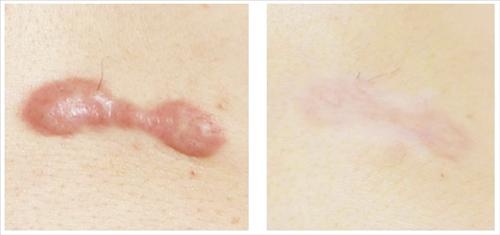켈로이드 상처란 손상된 피부 부위에 생기는 단단하고 고무 같은 섬유질 흉터입니다. 켈로이드는 기존 상처 부위보다 넓게 흉터가 생기고, 피부가 붉은색으로 변하고, ‘혹’처럼 솟아오릅니다. 표면은 광택이 나고, 불규칙한 모양을 띕니다. 흉터가 튀어나오고 통증과 가려움을 동반하기도 합니다.
켈로이드 상처의 발생원인은 정확히 밝혀지지 않았으나, 다음과 같은 요인들이 관련되어 있습니다.
- 켈로이드 가족력에 의한 유전
- 깊은 진피층 손상
- 지속적인 염증
- 당겨지는 힘(Tension)
유전적인 요인은 과민한 면역체계의 유전으로 인한 것으로, 부모님 중 한 분이 켈로이드 피부를 가지고 계신다면 자식도 켈로이드가 잘 생기는 피부를 가지고 있을 확률이 높습니다. 또 피부색이 진한 경우에 켈로이드 흉터가 더 많이 발생합니다.
깊은 진피층 손상은 외상, 수술 컷, 피어싱, 문신, 화상, 수두, 여드름 등으로 인해 발생할 수 있습니다. 이러한 상처는 정상적인 피부의 치유 과정에서 성장인자와 콜라겐의 합성과 분해의 균형이 깨져 비정상적인 흉터를 초래합니다.
지속적인 염증은 상처 부위에 감염이나 이물질이 있거나, 악세서리나 옷 등으로 자극을 받을 때 발생할 수 있습니다. 염증은 콜라겐의 과도한 생성을 촉진하고, 혈관의 확장을 유발하여 캘로이드 상처의 크기와 색깔을 더욱 두드러지게 만듭니다.
당겨지는 힘이란 피부에 걸리는 장력을 의미합니다. 이마나 어깨, 가슴, 배, 무릎 등에 상처가 생긴 경우에는 피부 자체의 당겨지는 힘에 의해 캘로이드 상처가 생기는 원인이 되기도 합니다. 제왕절개 수술 후 캘로이드 상처가 잘 생기는 이유도 피부의 장력과 회복과정에서의 염증이 원인이 됩니다.
캘로이드 상처의 치료방법은 다음과 같습니다.
- 스테로이드 병변 내 주사: 코르티손 등의 스테로이드 성분을 캘로이드 상처에 직접 주사하여 염증과 콜라겐의 생성을 억제하고 분해하는 방법입니다. 4-8주마다 주사를 반복하며, 흉터의 크기와 색깔을 줄일 수 있습니다.
- 냉동 치료: 액체질소를 캘로이드 상처에 발라 필요없는 세포를 얼리는 방법입니다. 몇 분 밖에 안 걸리며, 흉터의 크기를 크게 줄일 수 있습니다. 몇 주 간격을 두고 몇 차례 반복해야 합니다.
- 레이저 치료: 피부에 과도하게 발달된 혈관을 없애는 혈관레이저를 사용하여 캘로이드 상처를 축소시키고 치료하는 방법입니다. 혈관레이저는 혈관을 줄어들게 하여 조직으로 가는 혈액 자체와 염증을 줄여주는 효과가 있습니다.
- 수술 절개 및 방사선 절제: 캘로이드 상처를 제거하는 수술입니다. 주로 귓볼 캘로이드에 사용됩니다. 수술 후에는 방사선 치료를 병행하여 캘로이드 상처가 재발하지 않도록 합니다.
- 실리콘겔, 레티노이드: 캘로이드 상처 예방을 위해 실리콘 성분의 겔이나 연고를 사용할 수 있습니다. 실리콘 성분은 상처를 압박하여 회복과정에서 흉터가 증식되지 않고 정상적으로 회복되도록 하며 주변의 이물질로 인한 염증이 생기지 않도록 차단효과를 내기도 합니다. 레티노이드 성분은 병변의 피지억제효과를 통해 불필요한 면역반응을 줄여 염증을 최소화하는 효과를 냅니다.
다음은 켈로이드 상처에 대한 이미지입니다.

==========================================================
[English Version]
A keloid scar is a tough, rubbery scar tissue that forms on damaged skin areas. Keloids differ from regular scars as they grow larger than the original wound, turn the skin red, and protrude like a "tumor." The surface is shiny and irregular, and keloids may cause pain and itching.
The exact causes of keloid scars are not fully understood, but the following factors are associated:
- **Genetic predisposition to keloids:**
- If one of the parents has keloid-prone skin, there's a higher likelihood that their child will also have a tendency to develop keloid scars. Additionally, individuals with darker skin tones are more prone to keloid scarring.
- **Deep dermal layer damage:**
- Trauma, surgical incisions, piercings, tattoos, burns, chickenpox, acne, and other injuries can lead to keloid formation. These wounds disrupt the balance of growth factors and collagen synthesis and breakdown during the normal healing process, resulting in abnormal scarring.
- **Persistent inflammation:**
- Inflammation can occur due to infections, foreign bodies in the wound, or irritation from accessories or clothing. Inflammation stimulates excessive collagen production, promotes blood vessel dilation, and accentuates the size and color of keloid scars.
- **Tension on the skin (Tension):**
- Scars on areas like the forehead, shoulders, chest, abdomen, and knees can develop into keloids due to the skin's inherent tension. This pulling force on the skin's surface is a contributing factor. Keloid scars are also more likely after cesarean section surgery due to skin tension during recovery.
Treatment options for keloid scars include:
- **Steroid injections into the lesion:**
- Steroids such as cortisone are directly injected into the keloid scar to suppress inflammation, inhibit collagen production, and facilitate breakdown. Repeat injections every 4-8 weeks can reduce the size and color of the scar.
- **Cryotherapy (freezing therapy):**
- Liquid nitrogen is applied to the keloid scar to freeze and remove excess cells. This brief procedure can significantly reduce the size of the scar. Several sessions spaced weeks apart may be required.
- **Laser therapy:**
- Laser treatment using vascular lasers helps reduce keloid scars by eliminating excessive blood vessels. This diminishes blood flow to the tissue, reducing inflammation and the prominence of the scar.
- **Surgical excision and radiation therapy:**
- Keloid scars can be surgically removed, especially for earlobe keloids. Radiation therapy may be employed post-surgery to prevent keloid recurrence.
- **Silicone gels, Retinoids:**
- Silicone-based gels or creams can be used for keloid scar prevention. They exert pressure on the scar, preventing excessive growth during the recovery process. Retinoid-containing products minimize inflammation and reduce immune reactions, aiding in scar minimization.
It's crucial to note that keloid scars may be challenging to treat, and the effectiveness of interventions can vary among individuals. Consulting with a dermatologist or a specialist is recommended to determine the most suitable approach for each case.

